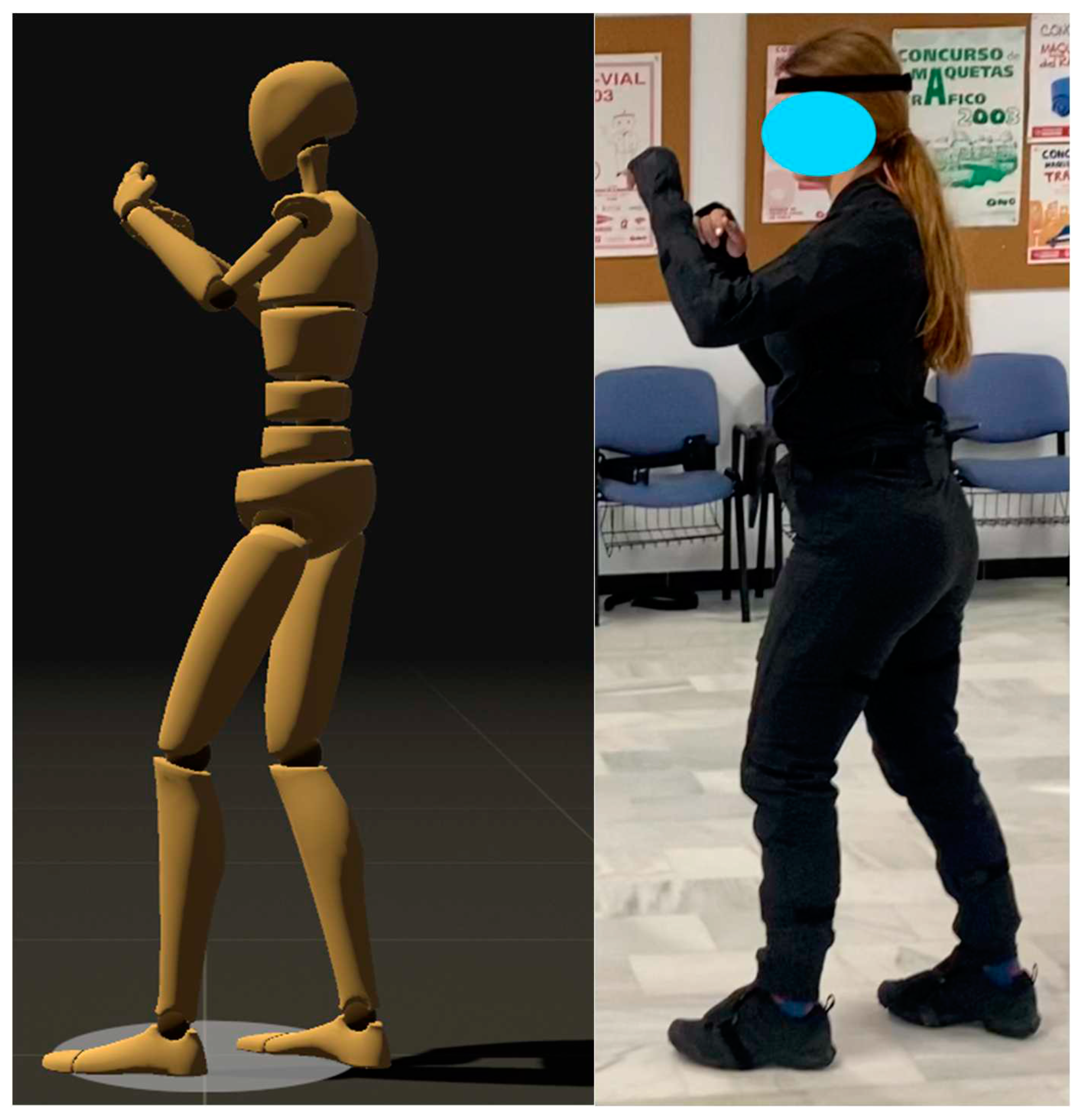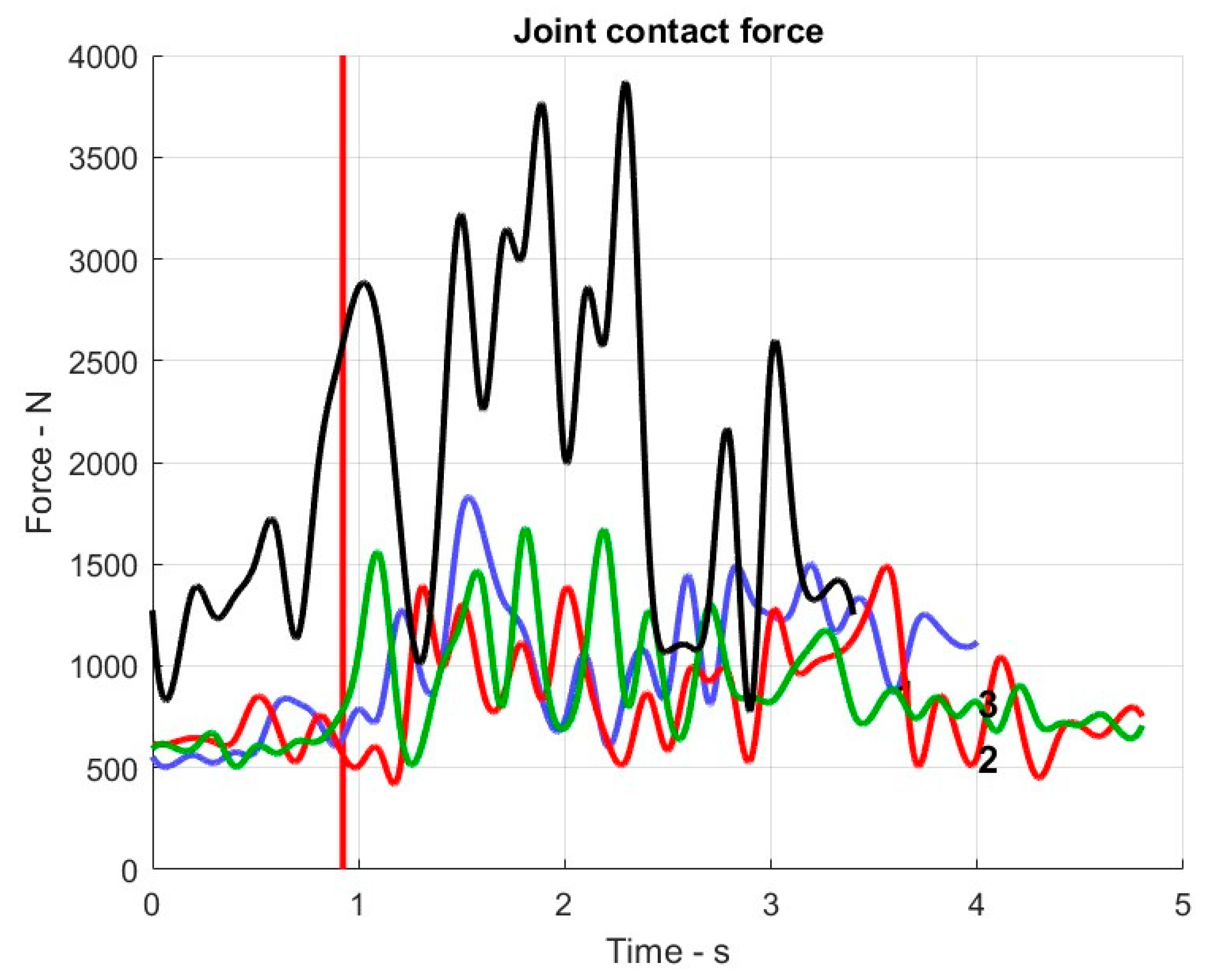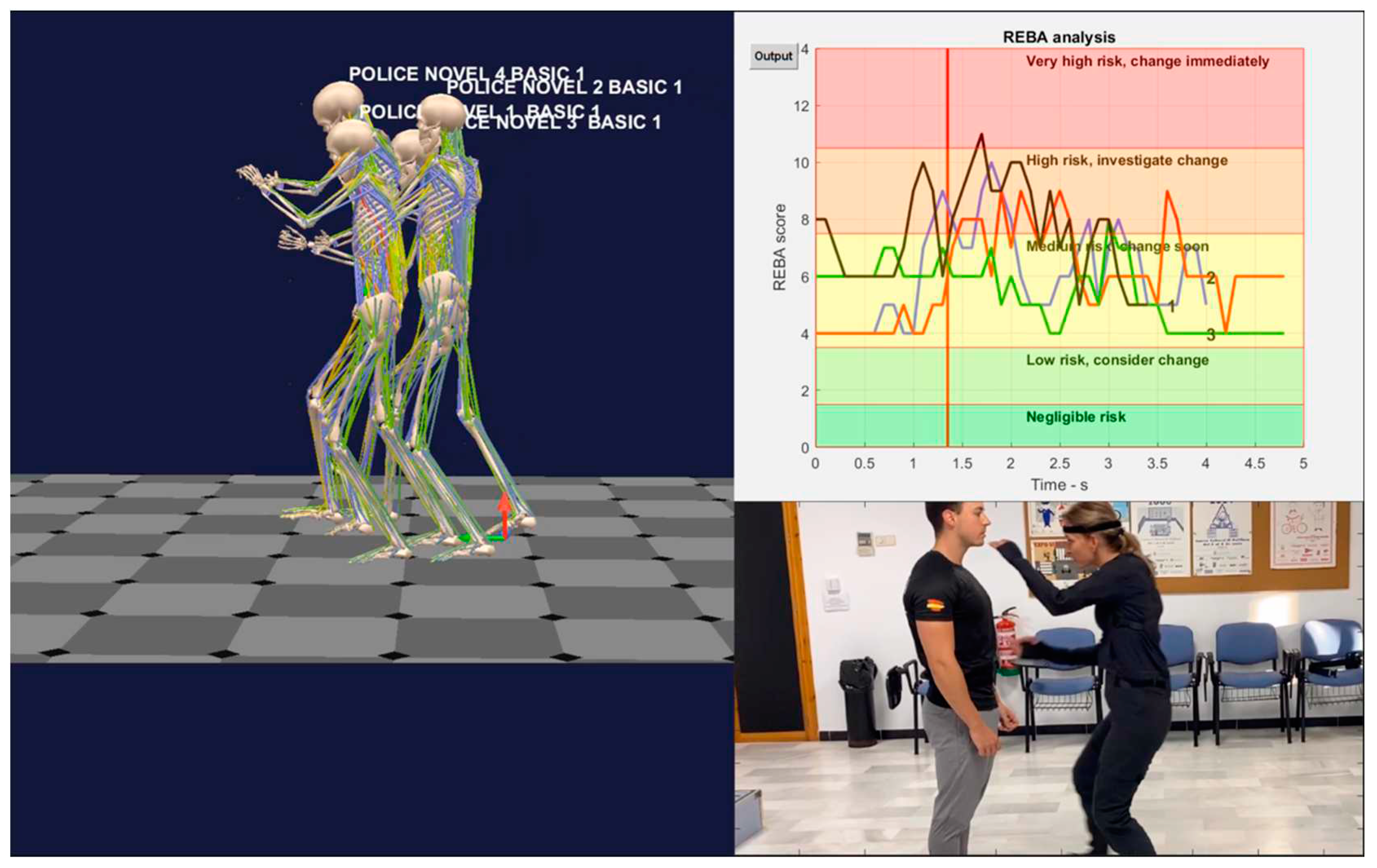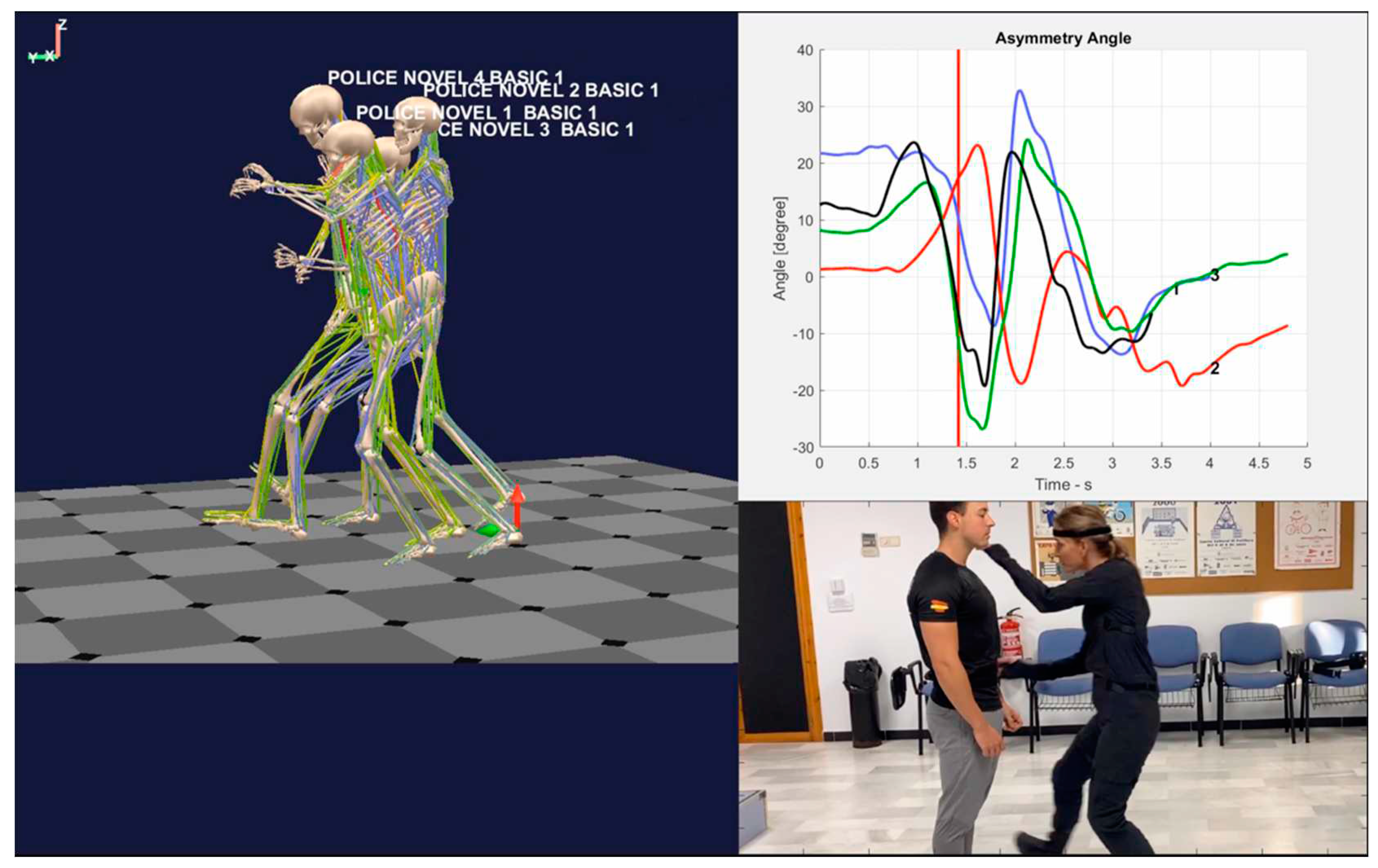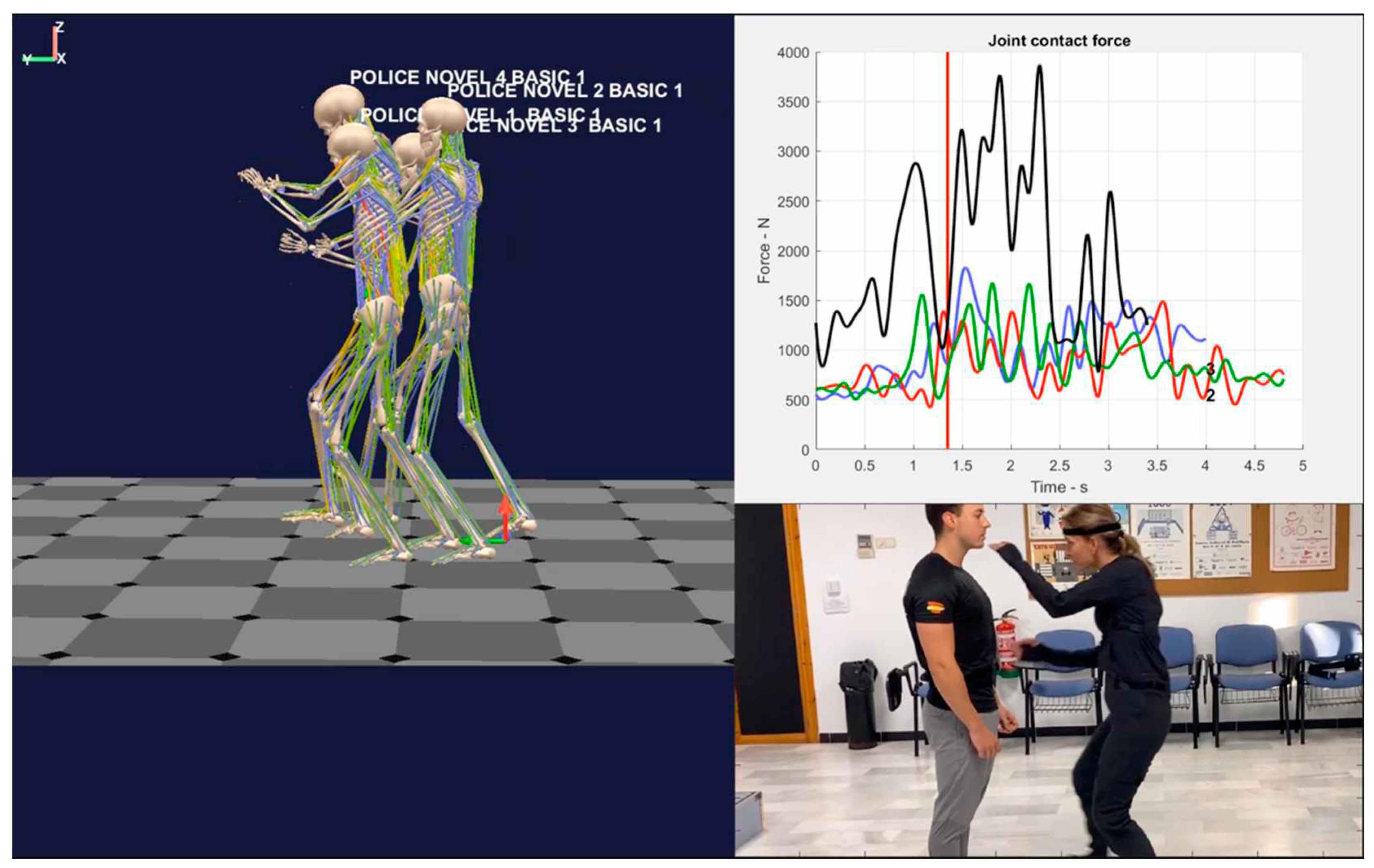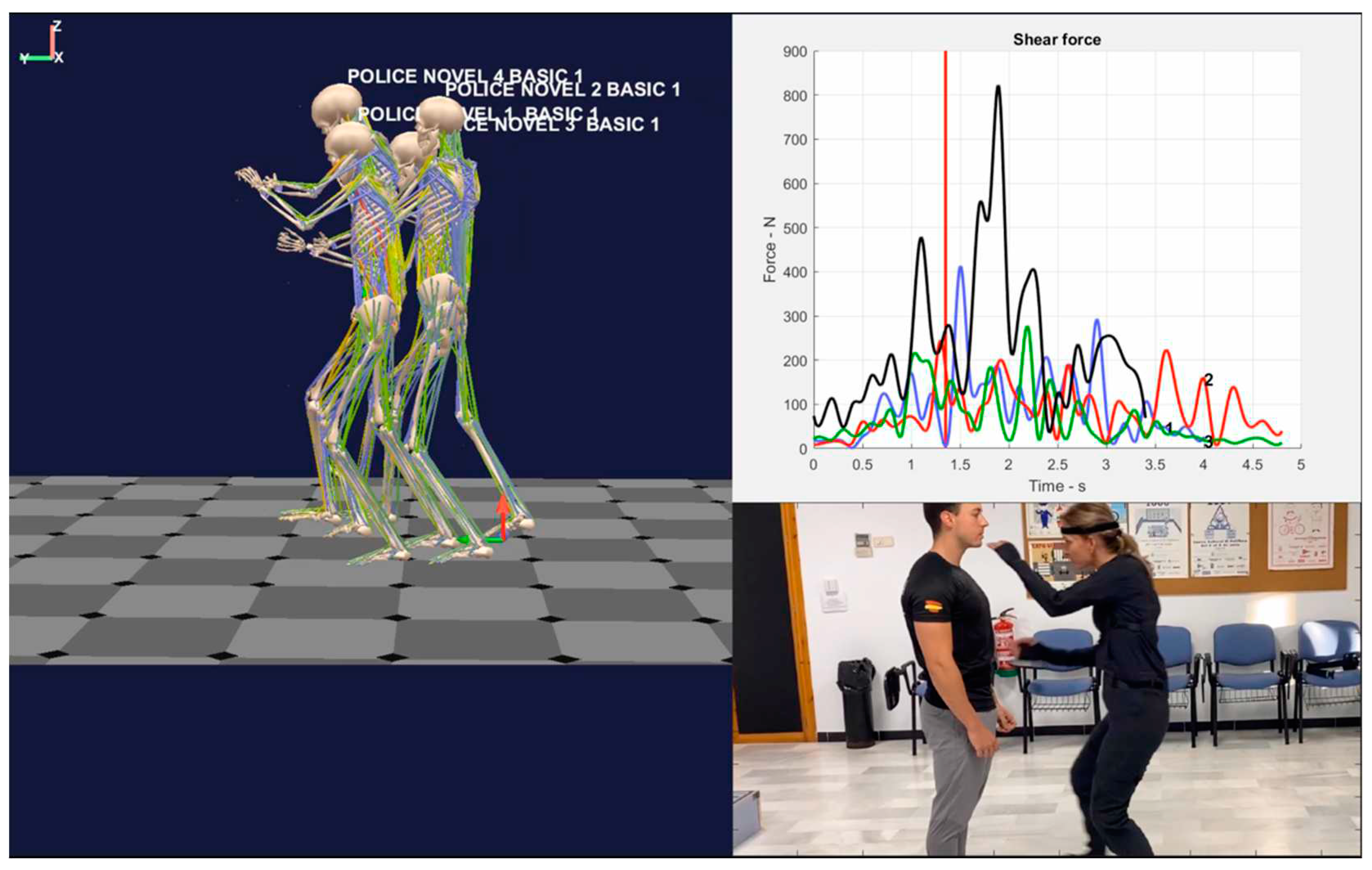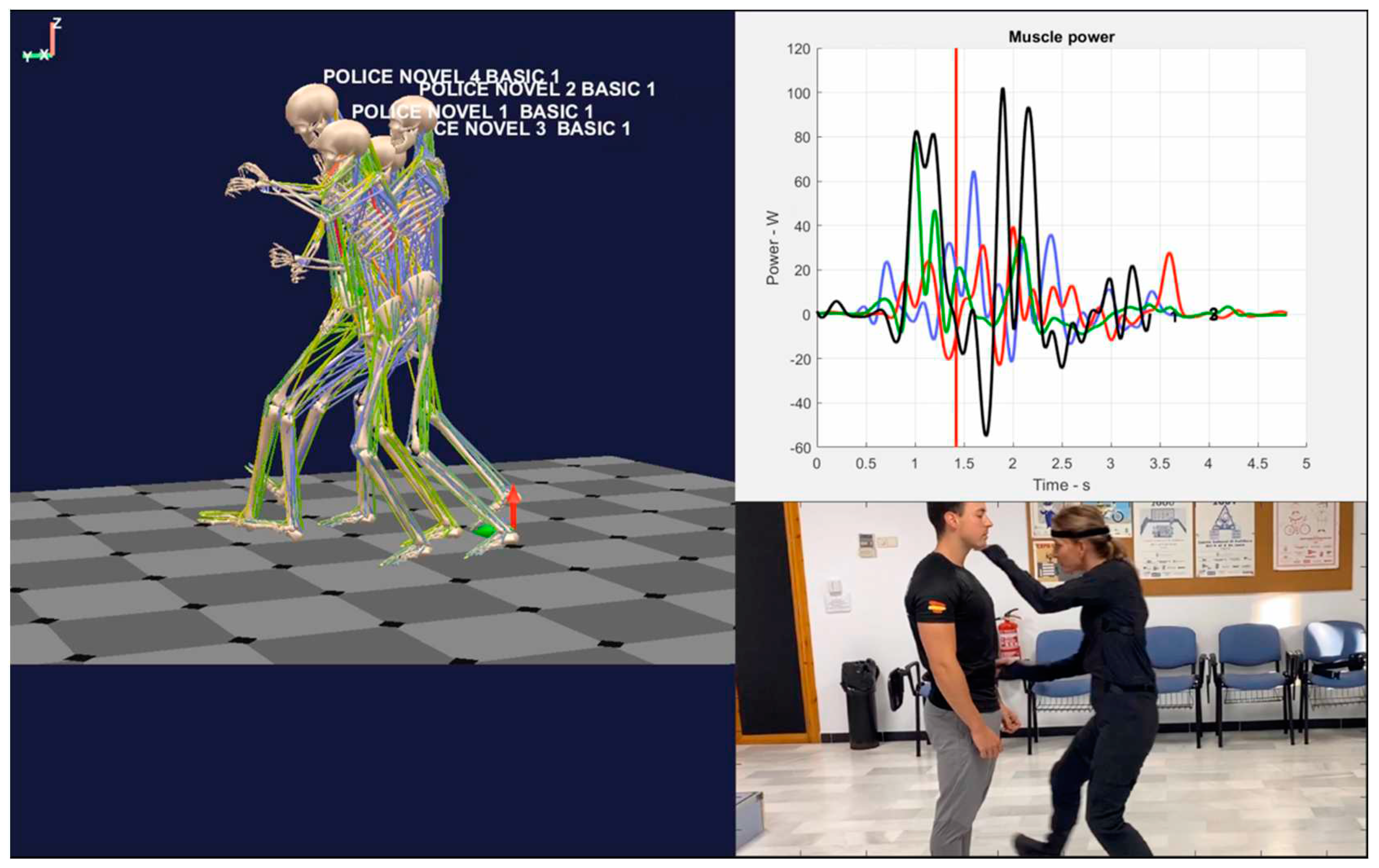1. Introduction
Because of some recent events in Spain, where police officers without an adequate training are being victims of approximately 35 attacks per day [
1], some doubts are being raised in different media regarding the level of self-defense training that police officers receive. The training of both public and private security forces is considered inadequate or deficient. The circumstances for security forces in Spain can be compared to that of a surgeon who has received a minimal training of just 70 hours and who, without any additional practice, is demanded to operate on patients.
According to a study by Strömmer, E.M.F. [
2], there is evidence that over time, law enforcement forces in the United States are inflicting more frequent and serious injuries to civilians.
From a macro approach to programs, the research studies conducted by Staller et all. [
3] suggest that there are some pitfalls with regard to the design of the training objectives and the actual design of the subsequent program. As a result, a lack of alignment between the training outcome and the performance expected from novice police officers in the field has been noted.
As far as European law enforcement agencies are concerned, they operate in a variety of contexts and their access to resources either for the management or for the delivery of training is also variable. Despite these differences regarding contexts and resources, European law enforcement agencies face common training challenges, such as the time consuming organizational and administrative processes required to implement any changes in the current training practices [
4].
There are numerous debates on the professionalization and reform of the police, which have increased since the death of George Floyd [
5], reflecting that there is much to be learned with regard to the scientific method used for police education and training [
6].
A recent study supports the doubts expressed in the present study on the effectiveness of police training and on a desirable more realistic approach to real-world violence [
7].
Police officers on patrol face different challenging contexts from a mental, social and physical point of view that can affect their life and health [
7,
8,
9]. These concerns encouraged Vera-Jiménez [
10] to conduct a local-scale study in Cádiz, a town in southern Spain with a population of slightly over 100,000 inhabitants. The study consisted on providing a group of municipal police officers with specific training based on OTP procedures [
11,
12]. It could be concluded that thanks to the employment of these procedures, the sick leaves of the officers were substantially reduced during the training period and for a certain period right after the training had been completed with respect to other periods when no OTP education had been provided. Unlike the currently endorsed classical police training methods, which are based on military instruction, martial arts and other fight and combat sports (MA/F/CS), OTP procedures have been developed in contrast to classical police training [
13] for two reasons: a) The harm caused to the concerned citizens when subjected to Physical Intervention Techniques (PITs) [
10,
14] and b) The high risk of injury for the police officers when performing such PITs [
10,
12,
15].
Thus, in Vera-Jiménez' study [
10] an anatomical map was already designed to indicate the areas of the human body of the citizens for which PITs were either recommended or forbidden. This map was the result of examining a series of judicial sentences issued by the Supreme Court with consequences against the police officers who had made use of force through traditional PITs [
14].
In order to determine the possible injuries that can be suffered by police officers, a suit fitted with sensors to capture motion and other variables (Rokoko Smartsuit Pro) has been used as a fundamental instrument for the purpose of this study. This equipment provides a set of data that can be analyzed by Biomechanics of Bodies (BoB) software applications [
16], which manages the results in a rapid and reliable manner so that risks can be assessed by REBA [
17] or NIOSH. [
18].
1.1. REBA (Rapid Entire Body Assessment)
REBA (Rapid Entire Body Assessment) [
17] is an ergonomic tool used to analyze and evaluate the ergonomics of work tasks. It was developed to identify and prevent ergonomic risks in the workplace and to help design tasks in a way that reduces the physical load and the risk of musculoskeletal injuries in workers.
REBA [
17] is commonly used in industries where repetitive tasks or tasks requiring awkward or straining movements are performed, such as manufacturing, construction or health care. To perform a REBA assessment, a healthcare professional or ergonomist will observe the worker while performing a specific task and evaluate several factors, including:
1. Body posture: The position of the worker's joints and limbs while performing the task.
2. Required force: The force required to complete the task and whether this force is excessive or inadequate.
3. Repetition: Whether the task is performed in a repetitive manner and whether there is a risk of muscle fatigue due to repetition.
4. Task length: The length of time that the task is performed and whether this could contribute to fatigue or risk of injuries.
5. Vibration: If the task implies exposure to harmful vibrations.
After analyzing each one of these factors, they are assigned individual scores through a score table that allows to determine the total ergonomic risk. This total score indicates the level of ergonomic risk associated to the task so that specific actions towards ergonomic improvement, such as the modification of the operating procedures or the use of a safer equipment, can be implemented.
The main objective of REBA is to identify and address ergonomic hazards in order to contribute to a safer and healthier work environment that helps to prevent injuries or health problems to the workers.
1.2. Asymmetry angle
The asymmetry angle is a parameter used by the NIOSH method (National Institute for Occupational Safety and Health) (18) to evaluate the ergonomics and safety at the work place. The NIOSH method is a widely recognized and tool that is used to evaluate the ergonomics and safety of work tasks in order to prevent muscleskeletal injuries and other problems related to work conditions.
The asymmetry angle is determined by the angle formed by the position of a worker’s spinal cord with respect to the vertical line during a specific task. This parameter is used to evaluate the workers posture and to determine any asymmetry or significant misalignment that may increase the risk of injuries.
By using the NIOSH method, we seek to minimize the asymmetry angle, given that a greater angle may indicate an awkward position or posture that may cause strain or stress on the back or other parts of the body. Ergonomics professionals use this measurement to identify tasks that may require adjustments to improve their ergonomics and reduce the risk of injuries.
To summarize, the angle of asymmetry is an important parameter within the NIOSH method as it allows to assess a worker's posture in relation to an upright position and helps to identify the cases at the work place that may require ergonomic interventions to guarantee the safety and health of the workers. [
19].
1.3. Joint Contact Force
The compressive force at the L5-S1 pelvic junction or L5- pelvis joint refers to the load or pressure that acts along the vertical axis on this specific spinal joint. The L5-pelvisjoint is located between the last lumbar vertebra (L5) and the first sacral vertebra (S1) of the spine and is one of the critical areas in the spine that bears most of the body weight and the compressive forces when a person is standing, walking, or performing weight-bearing activities.
Compressive force at the L5-pelvisjoint is essential to the biomechanics of the spine and is directly related to the health and function of this region. This force will vary depending on the physical activity and posture of a person, but in general, it is important that the L5-pelvisjoint can adequately support and distribute the compressive forces in order to prevent injuries and ensure the stability of the spine [
20].
When excessive or inadequate loads are placed on the L5-pelvisjoint, the risk of spine-related injuries and disorders, such as herniated discs, disc degeneration, low back pain and other conditions, can increase. Therefore, understanding and managing the compression force at this joint is critical to maintain the health and function of the spine [
21].
1.4. Shear Force
The shear force at the L5-pelvis joint refers to the force that acts in a tangential or parallel direction to the plane of the joint between the fifth lumbar vertebra (L5) and the pelvis at the spine. In biomechanical terms, the shear force in this region of the spine relates to the forces that can be exerted laterally or in a horizontal direction at the L5-pelvisjoint area.
This shear force is an important component of the total biomechanical load that affects the spine and pelvis during a variety of activities, such as moving, lifting or loading at the lumbar region. Understanding the shear force at the L5-pelvis junction is relevant to assessing spinal stability and understanding how lateral forces can influence spinal health, particularly in the context of back injuries and/or disorders [
22].
Biomechanical research studies and other analysis often focus on the shear forces in this area to determine spinal biomechanics, develop strategies to prevent injuries and design therapeutic interventions. In addition, the shear force at the L5-pelvisjoint may be an important factor to be considered when treating and providing rehabilitation for lumbar spine conditions [
22].
1.5. Muscle Power
Total muscle power is an ergonomic parameter that may be relevant when assessing the tasks and performance of police officers and other professionals who engage in physically demanding activities. However, it is important to emphasize that the ergonomic parameters and assessments in the police field may vary according to the organization, country and specific circumstances of the police work [
23].
Total muscular power refers to an individual's overall ability to generate force or muscular work. This includes both strength in terms of maximum force (e.g., heavy lifting) and muscular endurance (the ability to maintain the exerted force for a long period of time). In a police context, total muscle power can be an important factor to determine an officer's ability to perform physical tasks, such as chasing a suspect, carrying heavy equipment, or maintaining endurance during an emergency situation [
24].
It is important to note that ergonomic parameters and specific assessments may vary depending on the policies and standards of the police bodies in each location, so it is critical that officers and police agencies adhere to the guidelines and protocols that have been established for their jurisdiction. In addition, ergonomic considerations may also relate to other aspects, such as equipment design, vehicle ergonomics, and training to prevent work-related injuries.
The present study deals with the application of the above parameters to the results achieved in the training of novice police officers on the Use of Force (UOF) based on the OTP basic technique 1. Our research has specifically focused on the risk of UOF-related injuries.
3. Results and discussion
The training received on the use of police force, specifically on the Operational Tactical Procedures (OTP) basic technique 1, which is used for arrest procedures to control a standing person, was evaluated by means of the Occupational Risk Assessment methods described in a previous work by Vera et al [
12] Police Ergonomic Parameters (PEP). Four (4) novice police volunteers from a group of 15 student attending the Course for Admission to Local Police Corps in Andalusia organized by the Institute of Emergencies and Public Safety of Andalusia (IESPA) at the School of Public Safety of the City of Cadiz. The training on Operational Tactical Procedures OTP spanned for 30 hours, which were divided into 2 hour sessions 3 days a week.
The ergonomic assessment was carried out by using a suit with 19 inertial sensors and the BoB software package, which allows the analysis of a large set of biometric parameters.
The graph above on the right side (
Figure 3.) shows the REBA scores of the 4 novice police officers when performing the OTP basic technique 1, where the highest REBA score was 15 indicating a "very high risk" level. The following results were obtained: Police officer 1 - Represented by the blue line reaches a maximum score of 10 and a "High risk" level. Police officer 2 - Represented by the red line reaches a maximum score of 9 and a "High risk" level. Police officer 3 - Represented by the green line reaches a maximum score of 8 and a "High risk" level. Police officer 4 - Represented by the black line reaches a maximum score of 11 and a "Very high risk" level.
Of the 4 policemen evaluated, only the novice policeman 4 represented by the black line obtained a scores of 11, which indicates a "Very high risk" level, and exceeds the parameters considered as suitable, which must be below a score of 10 or "High risk" level, as established in a previous work by Vera et al [
12]. Therefore, this novice police officer should continue his training until his risk level is reduced to "High risk" level or below with a score of 10 or lower.
Likewise, in
Figure 3, on the right hand side, below the REBA analysis graph, we can see the novice police officer 1 in blue, while wearing the 19 inertial sensors suit and executing the OTP Basic technique 1. On the right hand side we can see the avatars of the 4 evaluated police officers, two men and two women.
Figure 4 shows on the right hand side the asymmetry angle scores while the 4 novice police officers were performing the OTP basic technique 1, where a smaller asymmetry angle relative to the sagittal plane of the avatar represents a lower risk of injury for the police officers, with the following results: Novice police officer 1, represented by the blue line slightly exceeds 30 degrees. Novice police officer 2, represented by the red line slightly exceeds 20 degrees. Novice police officer 3, represented by the green line, just over 25 degrees. Novice police officer 4, represented by the black line, similarly to the police officer 3, just above 25 degrees.
It can be observed that none of the novice police officers hardly exceeds 30 degrees of asymmetry with respect to the sagittal plane, and that the execution pattern of the OTP basic technique 1 of the 4 police officers, two men and two women, remains roughly invariable throughout the execution of the technique, according to the asymmetry parameters established in a previous work by Vera et al. [
12].
Likewise, in
Figure 4, on the right side, below the asymmetry angle graph, we can see the novice police officer 1 (blue color), wearing the 19 inertial sensors suit on while performing the OTP basic technique 1. The avatars of the 4 assessed officers, two men and two women, are shown on the right hand side.
The NIOSH [
18] guidelines of the National Institute for Occupational Safety and Health regarding compressive force at the L5-pelvic junction, establish a limit value of 3400 N as the threshold that should not be exceeded for prolonged periods of time. This means that, in the context of OTP techniques, it is important to prevent this load from exceeding 3400 N for an extended period of time to reduce the risk of injuries at that specific area concerning the spine L5 vertebra and the pelvis.
The above graph on the right side (
Figure 5), shows the scores corresponding to the compression forces at the L5-pelvic junction, when the 4 novice police officers, two men and two women, were performing the OTP basic technique 1, where a load of more than 3400 N should be avoided. The results from the analysis were as follows: Novice police officer 1 - represented by the blue line, Novice police officer 2 - represented by the red line and Novice police officer 3 - represented by the green line, got scores below 2000 N. Novice police officer 4 - represented by the black line, exceeded 3800 N. These values can be considered as acceptable and the evaluation has been passed, according to the parameters established in a previous work by Vera et al. [
12].
Similarly, in
Figure 5, on the right hand side, below the graph corresponding to the compression forces at the L5-pelvic junction, we can see the novice police officer 1 in blue color and wearing the 19 inertial sensors suit while performing the OTP basic technique 1. The avatars of the 4 evaluated police officers, two men and two women, are shown on the right hand side.
We should bear in mind that in previous studies by Vera et al [
12]. it has been established that the recommended limit for shear force at this joint is 1000 N (newtons). The graph above (
Figure 6), on the right hand side, shows the scores of the shear forces at the L5-pelvic junction, when the 4 novice police officers, two males and two females, were carrying out the OTP basic technique 1. The results obtained were as follows: Novice police officer 1 - blue line; Novice police officer 2 - red line; Novice police officer 3 - green line; Novice police officer 4 - black line. All of the scores obtained by the four novice officers remained below the recommended limit of 1,000 N.
Likewise, in
Figure 6, on the right hand side, below the graph corresponding to the shear forces at the L5-pelvic junction, we can see the novice police officer 1 in blue, while wearing the 19 inertial sensors suit and performing the OTP basic technique 1. The avatars of the 4 assessed officers, two males and two females, are shown on the right hand side.
The lower the muscular force exerted by police officers under certain circumstances might imply a lower risk of musculoskeletal injuries to either the officer or the person subjected to the intervention. The use of excessive or inappropriate force during physical intervention techniques may increase the risk of injuries for both the officer and the person being subjected to such techniques.
In previous works by Vera et al [
12] it was established that the greatest registered muscle power consumption corresponding to the execution of the OTPs was around 340 W. The graph above (
Figure 7), on the right hand side, displays the Total muscle power values, when 4 novice police officers, two males and two females, perform the OTP basic technique 1. The results were as follows: Novice police officer 1 - blue line; Novice police officer 2 - red line; Novice police officer 3 - green line; Novice police officer 4 - black line. All of the scores obtained by the four novice officers remained below 100W .
Similarly, in
Figure 7, on the right hand side, below the Total muscle power graph, we can see the novice police officer 1, in blue, wearing the 19 inertial sensors suit on and executing the OTP basic technique 1. The avatars of the 4 assessed police officers, two men and two women, are shown on the right hand side.
On the other hand, it can be seen in
Figure 3,
Figure 4,
Figure 5,
Figure 6 and
Figure 7, that the trajectories of the arms of the novice police officers do not affect or put any pressure on vital organs, as recommended by Vera et al. [
11] in order to minimize the risk of serious or fatal injuries to the persons subjected to these techniques.
4. Conclusions
This is the first time that a study on the prevention of occupational risks based on the biomechanics of the human body is conducted on a group of novice local police officers. The study has been carried out on 4 police officers and has had a duration of only 30 hours, which is the training time scheduled for the initial training course for entering local police officers in Andalusia and was focused on the OTP basic technique 1. After the evaluation of certain parameters such as those measured through the REBA Risk Analysis, i.e. the asymmetry on the sagittal plane, the compression forces at the L5-pelvic junction, the shear force at the L5-pelvic junction and the total muscle power, it could be observed that some of those values certainly varied, according to the variability of the individuals, even though the values measured were similar to those established as Police Ergonomic Parameters in previous publications, and far from the values reached by the same parameters when measured on police officers performing traditional physical intervention techniques, in which case, the values would reach levels that indicate much higher risks.
In order to achieve a greater uniformity and more moderate (or even lower) risk values, a larger study with a larger sample size and longer training hours on the use of police force would be required.
Author Contributions
Conceptualization, J.C.V.-J., J.A.Á. and J.A.; acquisition financing, D.V.C., J.C.V.-J., and J.A.; research, J.C.V.-J., D.V.C. and J.A.; validation, J.C.V.-J., D.V.C., L.G.H., J.A.Á., A.P.-F. and J.A.; screen, J.C.V.-J.; methodology, J.C.V.-J., D.V.C., J.A.Á., J.C.V.-J. and J.A.; redaction—preparation of the original draft, J.C.V.-J. and J.A.; Writing—Correction and edition, J.C.V.-J. and J.A.; supervision, J.C.V.-J., D.V.C., L.G.H.., J.A.Á., J.C.V.-J., A.P.-F. and J.A. All authors have read and accepted the published version of the manuscript.
